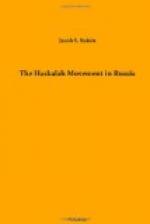That the rabbi, living in a strange land and recalling a glorious past, should have indulged in a bit of exaggeration in his sorrowful retrospect, is not more than natural; and that his picture on the whole is true is proved by similar schools which existed in Russia till recently. The descriptions of these institutions by Smolenskin as well as writers of less repute are graphic and intensely interesting. They constituted a unique world, in which the Jewish youth lived and moved until he reached man’s estate. In later years, when Russian Jewry became infected, so to speak, with the Aufklaerungs-bacilli, they became the nurseries of the new learning. But in the earlier time, too, a spirit of enlightenment pervaded them. The study of the Talmud fostered in them was regarded both as a religious duty and as a means to an end, the rabbinate. Even in the Middle Ages Aristotle was a favorite with the older students, and Solomon Luria complained that in the prayer books of many of them he had noticed the prayer of Aristotle, for which he blamed the liberal views of Moses Isserles![40]
Another typically, though not exclusively, Slavonic Jewish institution was the study-hall, or bet ha-midrash. As the synagogues gradually became Schulen (schools), so, by a contrary process, the bet ha-midrash assumed the function of a house of prayer. Its uniqueness it has retained to this day. It was at once a library, a reading-room, and a class-room; yet those who frequented it were bound by the rigorous laws of none of the three. There were no restrictions as to when, or what, or how one should study. It was a place in which originality was admired and research encouraged. As at a Spartan feast, youth and age commingled, men of all ages and diverse attainments exchanged views, and all benefited by mutual contact.
Those whose position precluded devotion to study availed themselves at least of the means for mutual improvement at their disposal. They organized societies for the study of certain branches of Jewish lore, and for the meetings of these societies the busiest spared time and the poorest put aside his work. It was a people composed of scholars and those who maintained scholars, and the scholars, in dress and appearance, represented the aristocracy, an aristocracy of the intellect.
Such was the pre-Haskalah period. From the meagre data at our disposal we are justified in concluding, that, left undisturbed, the Slavonic Jews would have evolved a civilization rivalling, if not surpassing, that of the golden era of the Spanish Jews. But this was not to be. Their onward march met a sudden and terrific check. Hetman Chmielnicki at the head of his savage hordes of Russians and Tatars conquered the Poles, and Jews and Catholics were subjected to the most inhuman treatment. The descendants of those who, in 1090, had escaped the Crusaders fell victims in 1648 to the more cruel Cossacks. About half a million Jews, it is estimated, lost their lives




